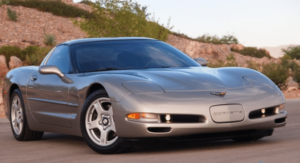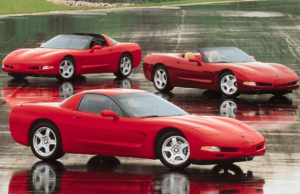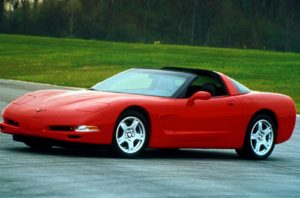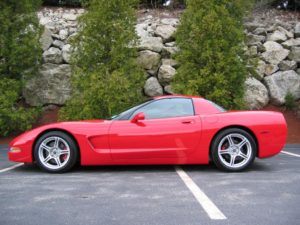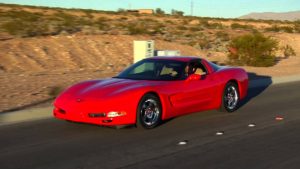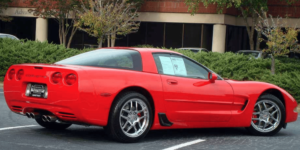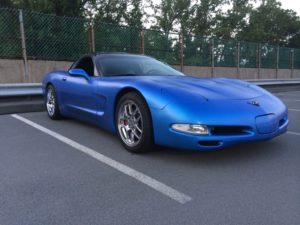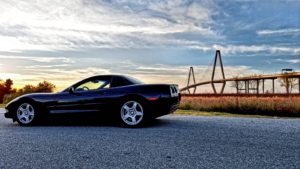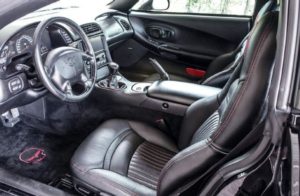From its inception in 1953, the Chevy Corvette has always been recognized as a vehicle that was a “step above the common car. Beginning with its earliest Motorama concept, to its first production models and beyond, the Corvette quickly became recognized and universally accepted as “America’s sports car” and, over time, became increasingly synonymous with the American dream – a dream in which every American could aspire to own a house, have 2.5 kids, and afford a sporty, two-seat, convertible coupe.
Pricing: $39,171.00 (coupe), $38,777.00 (FRC hardtop), $45,579.00 (convertible)
Engine options: LS1 346 C.I., 5.7 Litre V8
Transmission: 4-speed automatic (standard), 6-speed manual (optional)
Top speed: 169mph (Hardtop), 171mph (Coupe)
Units Produced: 33,270
Available Colors: Arctic White, Light Pewter Metallic, Sebring Silver Metallic, Nassau Blue Metallic, Navy Blue Metallic, Black, Torch Red, Magnetic Red Metallic
Highlights of the year:
Over time, the Corvette became a luxury item that fewer and fewer enthusiasts could readily afford to purchase. While this helped add an aura of exclusivity to the car, it also caused some within the General Motors corporation to question whether the Corvette franchise was headed down a path where increasing exclusivity might actually bring about an even greater decline in sales.
It was from this concern that actions were put into motion during the early planning phases of the C5 Corvette. Chevrolet had begun exploring the idea of creating a less-expensive, somewhat-stripped down variant of the C5 coupe that could be marketed as a “budget-conscious” Corvette.
While a few responded that there was a market for a budget-oriented Corvette, most agreed that developing a “cheaper” version of the very successful C5 would not only hurt sales of the other, more expensive variants, but It would also adversely impact the public’s perception of the Corvette. It seemed that the exclusivity of Corvette ownership that many within GM feared would hurt sales numbers was actually the thing that helped promote them.
Despite this revelation about their flagship automobile, the concept of producing a “stripped-down” Corvette continued to be an appealing idea for the car’s development and marketing managers. While sales campaigns would have to be selectively tailored to properly reflect the added benefit of purchasing a no-frills Corvette, it was decided that, for the 1999 model year, Chevrolet would move forward with a new variant of the Corvette – one that would focus on eliminating otherwise “unnecessary” features in favor of producing a performance-enhanced, reduced-weight vehicle. It was with this notion that the C5 hardtop Corvette was born.
The hardtop is the first fixed-roof Corvette since the 1963-67 Sting Ray coupe. When the C5 was being developed three years ago, Chevy asked chief engineer Dave Hill to figure a way to make a cheaper Corvette. At the time, the factory in Bowling Green, Kentucky, wasn’t selling all the Corvettes it could make. Hill says he looked at a C5 coupe’s one-by-four-inch-thick tubular steel roll hoop and imagined it fastened to the body of a convertible, covered by a lighter but stronger fixed panel without the heavy glass of the hatchback.
Originally, the hardtop was to be a stripper that would put a Corvette in at least double the number of driveways it occupied at the time, if not on every American block. So prototypes were built with cloth-covered, manually operated seats; smaller 17-inch tires front and back; and a few other cost-saving tricks by Chevy. For example, these prototypes were built with the less-expensive four-speed automatic transmission (about 60 percent of Corvettes are sold with automatics). In these prototypes, the cost-cutters also left out the electronically variable shock-damping system, the traction control, and the brake-controlled active-handling stability system.
Every 1999 Corvette had a comprehensive standard safety package that included state-of-the-art dynamic stability technology as well as occupant protection features. This advanced safety package was the result of GM’s unmatched worldwide research and testing facilities. Standard occupant protection features included Next Generation driver and passenger airbags, safety/shoulder belts, front and rear crush zones, and safety cage construction with integral side door beams. Equally important were the advanced crash avoidance features standard in every Corvette. They included Daytime Running Lamps, ABS, and Traction Control.
There’s a reason one would feel secure in a 1999 Corvette. It was designed that way. Daytime Running Lamps are standard. These lamps (which operate in conjunction with turn signals) come on automatically to help other road-way users notice your oncoming vehicle during daylight hours. All the windows were tinted, and the windshield featured Solar-Ray glass, for reduced heat buildup. The high-strength windshield was made of lightweight, urethane-bonded laminated glass. Next Generation driver and passenger airbags supplement the lap/shoulder safety belt system to help restraint the driver and passenger in the event of a moderate to severe frontal impact. Drivers were advised to always wear safety belts, even with airbags. Audible front brake wear sensors gave indication when it was time to replace front brake pads. Four-wheel disc brakes with ABS provide powerful stopping performance.
Total sales of the 1999 Corvette increased from the previous model year by more than two-thousand units, totaling 33,270 Corvettes in all. The Hardtop Coupe (FRC) Corvette certainly helped in this department, accounting for 4,031 of the total Corvettes sold that year. While Chevrolet’s focus continued to be to increase total units sold, 1999’s production run was certainly respectable – and promising that the Corvette’s long-term future looked increasingly optimistic.
Photos of the 1999 Corvette:
Sources:
https://www.corvettemuseum.org/learn/about-corvette/corvette-specs/1999-corvette-specs/
https://www.caranddriver.com/reviews/a15113873/1999-chevrolet-corvette-hardtop-road-test-review/
https://www.corvsport.com/1999-c5-corvette/
https://www.corvsport.com/1999-c5-corvette-image-gallery/
